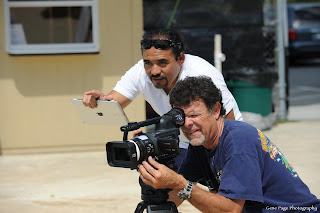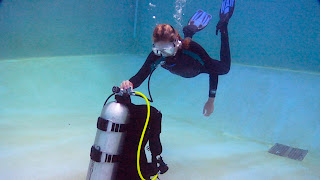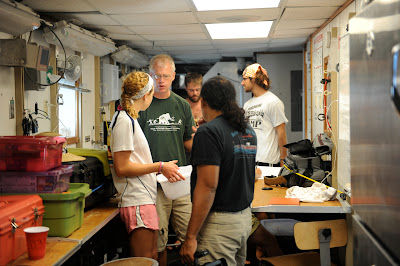 |
A first glimpse of tropical paradise on the short flight
from Orlando to Nassau. More pictures HERE. |
Once we motored away from the hustle and bustle of Nassau,
New Providence, we saw nobody else. Besides catching a glimpse of an occasional
yacht or rooftop peeking from amongst the trees of a nearby island, there was
little sign of human life. For a week, we were our own floating microcosm
surrounded by azure waters.
 |
A good luck double rainbow spanned the sky as we left
Nassau harbor and bid us a warm and friendly goodbye
on our week-long voyage. |
Each day for a week, we strapped tanks on our backs, stepped off the
stern of the Carib Dancer, and descended, cameras in hand. Without a tank or
camera I have started to feel naked, or perhaps like a beached mermaid stranded
on shore. Trying to walk on solid ground for the past few days has been a bizarre
experience as I continually anticipate a sudden jolt from a wave and expect a constant, subtle
rocking motion.
Every morning, we rose with the sun and did 4-5 dives
throughout the day. We significantly modified the “Eat, Sleep, Dive” motto that
is popular on the bumper stickers and shirts of diving enthusiasts. Instead, a
typical day went something like this: eat, dive, dive, eat, dive, dive, eat,
dive, sleep. Repeat. Usually, the dives lasted about an hour, so
being underwater for upwards of four hours a day was both a dream come true and
an amazing learning experience.
 |
| Try to take the camera away. I dare you. |
Others on the trip ranged from well-traveled recreational
divers with mini cameras to professional and practically-professional
photographers and videographers. It was an extremely talented and diverse group
of divers from all over the US, Canada, and Caribbean Islands. David Ulloa
(Valeo Films Inc.) and John Ellerbrock (Gates Underwater Housings) co-hosted
the event and brought expertise as well as entertainment and inspiration.
Underwater, it was helpful to observe the different videographers,
each with his or her own unique techniques and styles.
 |
I quickly became familiar with different divers’ silhouettes
from a distance based on their camera and swimming
style – some cameras looked like alien spaceships
operated by underwater astronauts. David, often seen
with the big HVX “beast” camera, was easy to spot
diving single side mount along with Dee |
Above water, when not found lounging on the sun deck,
downloading videos from previous dives, or taking pictures, we often watched
short videos by David and John and talked about photography and videography
techniques. Besides David’s movies, which have inspired me from the beginning,
I fell in love with two videos by Howard Hall: “The Blue Ocean in RED” and “100
Miles”. Sadly I can’t find “100 Miles” online, but I still literally
cannot stop watching “The Blue Ocean in RED.” The way he composes the video gives the viewer an amazing feeling - it is as if you are underwater at that precise moment. I liken it to a brilliant underwater ballet. The perfectly arranged music is timed flawlessly with both the
motion of the sea and the action of the sea life - this is something
that I strive to do in my own work after many more years of practice and dedication. He has
the ability to capture an organism not only in action but also doing something interesting
and doing it naturally. It is as if he is not even there with a huge camera. The viewer is at once swept off the couch and is able to view the reef as another member of the school of fish or as a remora casually hitching a ride on a shark.
 |
| While the red lionfish (Pterois volitans) is undeniably a beautiful fish, it is also an invasive species and is wreaking havoc on reefs all over the Caribbean. They are mesmorizing to watch as they swim slowly and hover gracefully in the water, but behind their mask of beauty lies poisonous spines and a voracious appetite. Unfortunately, we saw at least one (but usually between 4-6) on every dive, even at depths down to 100+ feet. |
 |
| Corals have an amazing ability to grow at crazy angles all over the reef - this Gorgonian is growing at a 90 degree angle to the vertical wall, therefore exposing itself to the maximum amount of sunlight for photosynthesis. Its branching arms create a maze-like effect as I look directly up towards the sky from about 80 feet below the surface. |
Another neat aspect of the trip was
that John and Jennifer brought their OTS full face masks. The mask is integrated
with a regulator and there is no mouthpiece, so you can easily communicate both
with your buddy and people at the surface. His masks have a wide variety of uses, including applications in the military, FBI, film and video production, and recreational diving. They also make for a nice Darth-Vador-like look.
 |
| While I never actually tried a full face mask in the water, I did listen to a few divers talking underwater while I was on deck with Jennifer. This technology definitely has the ability to greatly enhance science and research underwater and I can’t wait to try it! Here, David and Dee (sporting single side mount tanks) are getting ready to giant stride off the stern for their first full face mask dive of the trip. |
By the end of the week, I was feeling a bit more comfortable with different settings and adjustments on the more complicated cameras, but it is certainly a never-ending work in progress. I spent considerable amount of time above and below water messing with the white balance, ND filter, and using auto versus manual focus. But of course once I felt almost comfortable with one camera, I would try another and be totally thrown off and take an entire dive or two to attempt to adjust to the new one. I felt lucky to be surrounded by the perfect people to answer my million-and-one questions, no matter how trivial. I think one of the keys to success is going to be getting familiar with one camera and learning how to operate it out of the housing first - once I know it and it's settings like the back of my hand, it will be easier to adjust underwater in the housing. So now it's time to practice. I also learned a lot about importing files and file types and had a blast playing with the GoPro. I ended up getting some pretty cool stills from GoPro footage. It's a truly amazing little camera, about the size of an iphone folded in half, and it records in HD!
The highlight of the trip for me was making a real
connection with sharks for the first time. Ever since seeing David's GoPro footage from Tiger Beach and watching Touched by a Shark countless times, my view of sharks changed. It is a drastic change, because images engrained in our brains by modern media and crazy camera effects turn these brilliant fish into voracious killers of the deep. As I jumped in the water at Amberjack Reef and swam with one little lemon shark, I felt emotions that I only felt so strongly when I first watched Touched by a Shark - this magnificent fish was curious but much more scared than me. Using animal and shark behavior tips from David, I was able to keep her attention and have her swim along with me, the whole time playing back what David had told me that morning - "when you jump in the water, have a purpose; do your own thing, they are curious and will approach you; don't follow or chase them; don't be nervous, they can sense your heartbeat; they know you are the predator so you shouldn't be scared, otherwise it scares them." And the minute I saw the first of three sharks on this first dive, this all came in to play. She was curious when I splashed off the stern, and she came up to me as I turned on my GoPro. I calmly looked at her glassy eyes as she approached me, dorsal fins flat in a comfortable, unthreatened swimming stance. She got closer then turned and instead of chasing, I mirrored her and swam alongside. She had her eye on me the whole time and swam for a minute but it felt like an eternity - one of the best minutes of my life (until she came back a few minutes later to play again!).
 |
| And for a few seconds, the world stood still as I admired one of the most beautiful and misunderstood creatures on the planet. Since the trip, I have been reading Demon Fish by Juliet Eilperin, a reporter for The Washington Post who came and spoke to my senior environmental seminar at Brown last spring. She describes the evolving relationship between humans and sharks and reveals many secrets of these mysterious creatures, viewed by the overwhelming majority as ruthless killers. Many societies used to worship sharks, but unfortunately it has come to this: “For the most part we still see the sea as a source of valuable commodities we can extract, whether it’s the fish we eat or the oil we drill... Sharks and other commercial fish are something for humans to capture, not cultivate. We seek to defeat their wildness, rather than admire it.” ~Juliet Eilperin, Demon Fish |
 |
On the final day of the trip, we splashed at 7am.
We were greeted by a phenomenal sunrise and equally
magnificent dive into the Blue Hole. |
 |
| Dee shines her light towards the dark vertical wall of the Blue Hole at ~80 feet. |
 |
| After a few bad run-ins with jellyfish over the past few years, they are not exactly my favorite creatures. But I am starting to come to terms with my Cnidaria-phobia, especially after really examining how beautiful they really are in a series of pictures I took during my safety stop on the way up from Blue Hole, the last dive of the trip. |
LOA: 100’
Passengers: 14
Crew: 5
Dive Summary:
-17 total dives at 16 sites
-961 minutes (16 hours) underwater
-Max depth 121’
16 Dive Sites:
Pillar Wall, Jewfish Wall, Blacktip Wall, Barracuda Shoals, Flatrock Reef, Up Jump the Devil, Dog Rocks, Hammerhead Gulch, Amberjack Reef, Jeep Reef, Danger Reef, Cracked Coral Head, Close Mon, Lobster No Lobster, Blue Hole
Videos:
Two of the divers on the trip put together amazing videos. Michael's video is a compilation of footage from everyone on the trip and Beat's video is his own footage. I'm working on making a video now too and will publish the link as soon as I finish.
><((((°> ><((((°> ><((((°> ><((((°> ><((((°> ><((((°> ><((((°> ><((((°>
.JPG)





























+DSC_0054.jpg)
